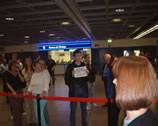

Dublin has grown rapidly since the foundation of the State, principally because of its importance as an intellectual and administrative centre. The population of the built-up area of the city increased from 419.000 in 1926 to over 1 million in 1986. The statistical result of this growth is that Dublin's current population of 1,070.429 now accounts for 29% of the State's entire population. In the early 1980s more than half of the city's population was under 25, and although the number of births is declining every year, Dublin will remain for the foreseeable future a very young city. 25% of the city's current population is still of school-going age.
The city has always been a melting pot, attracting to this day native Irish from rural areas in search of employment, attracting in the past foreign invaders who intermarried and settled, and today magnetic more and more people from around the globe in search of a relationship with, and an understanding of, the city, its people and its culture. Many of these latter-day immigrants arrive to take up positions of employment in the many vibrant areas of the Irish economy.